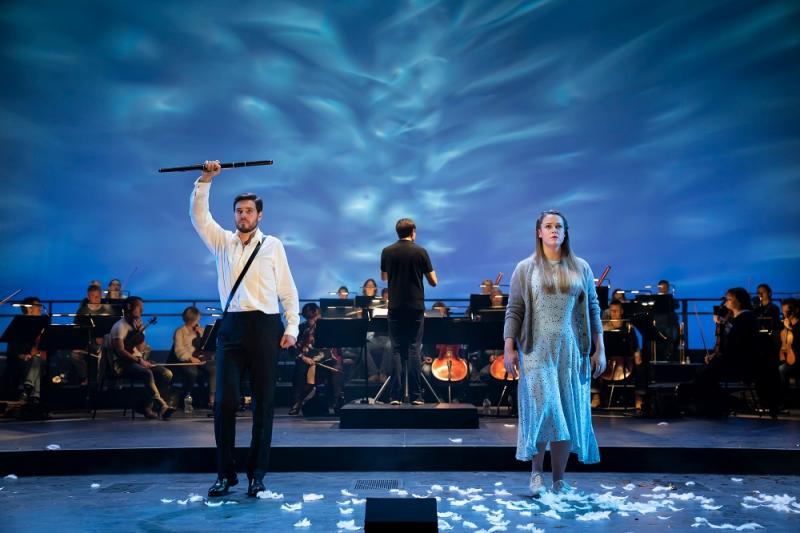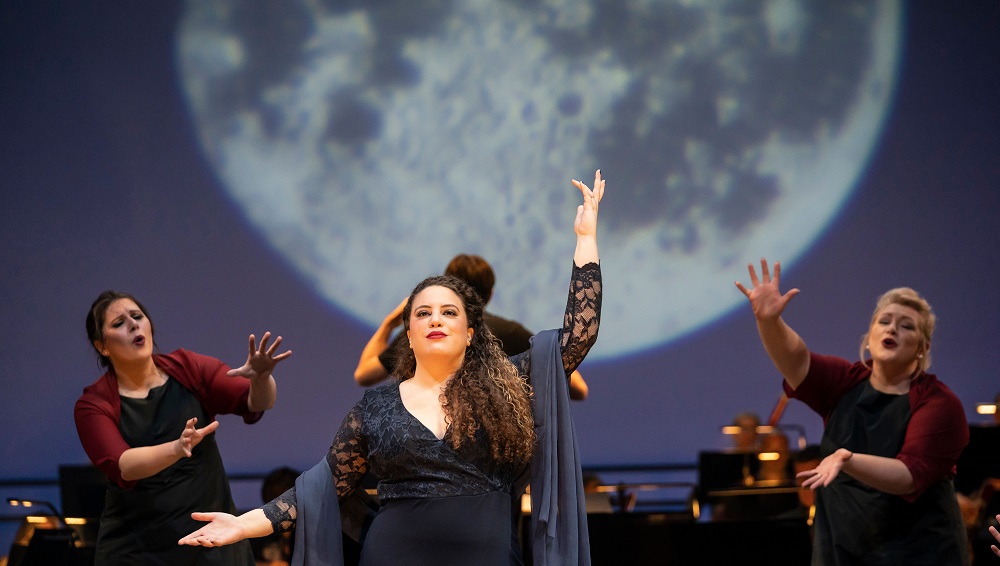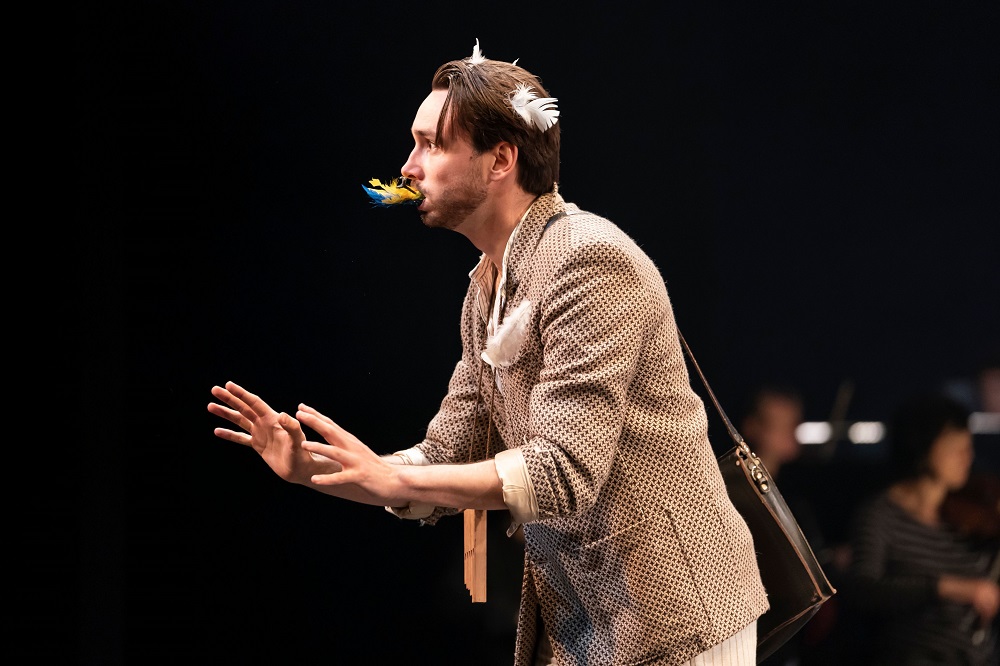The Magic Flute, Glyndebourne review - deeply moving light in darkness | reviews, news & interviews
The Magic Flute, Glyndebourne review - deeply moving light in darkness
The Magic Flute, Glyndebourne review - deeply moving light in darkness
Ninety minute concert staging showcases superb young singers

How does Mozart do it? His music can provoke deep emotions even in the unlikeliest operatic situations, if well done, and present circumstances stirred them up all the more on Sunday afternoon.
The youth of most of these first-rate singers heightened feelings of happiness, regret and a gratitude that Glyndebourne was offering the real Mozartian thing – full Glyndebourne Tour Orchestra conducted by Leo McFall included. Had you been following their careers, it was all the more remarkable to see how far they’d come. None more so than Nazan Fikret, unforgettable as a petulant-scary child in Britten’s The Turn of the Screw, graduating to a rather touching Governess in a North Norfolk production directed by a friend of mine, and now a Queen of the Night who would grace any stage in the world (pictured below with two of her ladies, Carrie-Ann Williams and Eirlys Myfanwy Davies). Indeed, I’ve never heard a better for the combination of steely regality and not only all the ear-popping top notes but all the ornamentations accurately done as well.  Former Royal Opera Jette Parker Young Artist Thomas Atkins, who sang Idomeneo's "Fuor del mar" in the 2017 Europe Day Concert at St John’s Smith Square, has graduated to a regal prince all too likely to respond to the lofty theatrics of the star-blazing queen. From the start he suggests lyric-heroic tenor in the brightest terms, though he can be softly caressing, too, as he was at a surprising late stage in the aria where Tamino contemplates a (here living) portrait of Pamina. Gemma Summerfield, an obvious star in the making for Ian Page’s Classical Opera, brings the full radiance of youthful soprano to Pamina; the closing stages of her lament were magically hushed, too, and the moments where time stands still – in Act One when she tells Papageno to “be truthful”, in Act Two where she greets her prince before the trials, and meets a similar response of heartbreaking tenderness, simply perfection.
Former Royal Opera Jette Parker Young Artist Thomas Atkins, who sang Idomeneo's "Fuor del mar" in the 2017 Europe Day Concert at St John’s Smith Square, has graduated to a regal prince all too likely to respond to the lofty theatrics of the star-blazing queen. From the start he suggests lyric-heroic tenor in the brightest terms, though he can be softly caressing, too, as he was at a surprising late stage in the aria where Tamino contemplates a (here living) portrait of Pamina. Gemma Summerfield, an obvious star in the making for Ian Page’s Classical Opera, brings the full radiance of youthful soprano to Pamina; the closing stages of her lament were magically hushed, too, and the moments where time stands still – in Act One when she tells Papageno to “be truthful”, in Act Two where she greets her prince before the trials, and meets a similar response of heartbreaking tenderness, simply perfection.
Baritone Huw Montague Rendall (pictured below) many of us already know as a stage natural, and his Papageno had charm as well as a never overdone comedy, all the better perhaps for the spoken dialogue being trimmed to a minimum (though Jeremy Sams's translation is witty with it). It's no surprise to learn that he'll be singing Guglielmo in Così fan tutte next Glyndebourne season (inshallah). Greater authority and vocal security were needed only from David Shipley’s Sarastro; that should come in time. The other roles were all taken at the highest level, and namechecks are due for Williams, Kamilla Dunstan and Davies as three very lustrous three ladies, David Shaw as lustful Monostatos, clarion tenor Brenden Gunnell and true young bass William Thomas as the two priests/armed men, late step-in Madison Nonoa-Horsefield as a Papagena filling her brief time on stage with personality.  Inevitably there were musical casualties in a show which could probably have stretched to two unintervalled hours like Garsington's musically complete Fidelio – the biggest being the platonic duet about love between Papageno and Pamina as well as the playful-sublime music for the Three Boys – but we did get a 14-strong chorus, bolstered by some of the smaller-part principals in a resonating chorus to Isis and Osiris and by the rest of the cast in the sun-drenched finale. Donna Stirrup's staging hit the minimal mark early on with feathers and picture frame, but had no more success with Sarastro’s brotherhood than most, suggesting him as a suited demagogue with American tinsel pom-poms to support his campaign. Still, the projected moon, sun, water and fire were all we needed for the cosmic dimensions.
Inevitably there were musical casualties in a show which could probably have stretched to two unintervalled hours like Garsington's musically complete Fidelio – the biggest being the platonic duet about love between Papageno and Pamina as well as the playful-sublime music for the Three Boys – but we did get a 14-strong chorus, bolstered by some of the smaller-part principals in a resonating chorus to Isis and Osiris and by the rest of the cast in the sun-drenched finale. Donna Stirrup's staging hit the minimal mark early on with feathers and picture frame, but had no more success with Sarastro’s brotherhood than most, suggesting him as a suited demagogue with American tinsel pom-poms to support his campaign. Still, the projected moon, sun, water and fire were all we needed for the cosmic dimensions.
The orchestra kept it sweet and light for McFall; one early entry and two brief out-of-syncs apart, the singers were with the players behind them throughout. And we were with them throughout – I’m sure they felt that. And they will feel it once more on Tuesday before the house goes dark again for what should have been eight more performances throughout November (we've been here before - English National Opera's new Marriage of Figaro managed one night only in March). All circumstantial precautions were admirably handled, proving that the show could go on had the government not khyboshed the possibility (and in any case jaunts beyond your home territory will be forbidden). If Glyndebourne can find a way to film it, I’d happily watch again – not always the case in an ocean of livestreams when so many of us are still hungry for the real "magic triangle" - as Britten put it, and I'm always keen to repeat it - of composer, performers and audience so palpable yesterday.
- One more performance at Glyndebourne on Tuesday before the house closes due to new Covid-19 restrictions
- Read more opera reviews on theartsdesk
rating
Explore topics
Share this article
The future of Arts Journalism
You can stop theartsdesk.com closing!
We urgently need financing to survive. Our fundraising drive has thus far raised £49,000 but we need to reach £100,000 or we will be forced to close. Please contribute here: https://gofund.me/c3f6033d
And if you can forward this information to anyone who might assist, we’d be grateful.

Subscribe to theartsdesk.com
Thank you for continuing to read our work on theartsdesk.com. For unlimited access to every article in its entirety, including our archive of more than 15,000 pieces, we're asking for £5 per month or £40 per year. We feel it's a very good deal, and hope you do too.
To take a subscription now simply click here.
And if you're looking for that extra gift for a friend or family member, why not treat them to a theartsdesk.com gift subscription?
more Opera
 Albert Herring, English National Opera review - a great comedy with depths fully realised
Britten’s delight was never made for the Coliseum, but it works on its first outing there
Albert Herring, English National Opera review - a great comedy with depths fully realised
Britten’s delight was never made for the Coliseum, but it works on its first outing there
 Carmen, English National Opera review - not quite dangerous
Hopes for Niamh O’Sullivan only partly fulfilled, though much good singing throughout
Carmen, English National Opera review - not quite dangerous
Hopes for Niamh O’Sullivan only partly fulfilled, though much good singing throughout
 Giustino, Linbury Theatre review - a stylish account of a slight opera
Gods, mortals and monsters do battle in Handel's charming drama
Giustino, Linbury Theatre review - a stylish account of a slight opera
Gods, mortals and monsters do battle in Handel's charming drama
 Susanna, Opera North review - hybrid staging of a Handel oratorio
Dance and signing complement outstanding singing in a story of virtue rewarded
Susanna, Opera North review - hybrid staging of a Handel oratorio
Dance and signing complement outstanding singing in a story of virtue rewarded
 Ariodante, Opéra Garnier, Paris review - a blast of Baroque beauty
A near-perfect night at the opera
Ariodante, Opéra Garnier, Paris review - a blast of Baroque beauty
A near-perfect night at the opera
 Cinderella/La Cenerentola, English National Opera review - the truth behind the tinsel
Appealing performances cut through hyperactive stagecraft
Cinderella/La Cenerentola, English National Opera review - the truth behind the tinsel
Appealing performances cut through hyperactive stagecraft
 Tosca, Royal Opera review - Ailyn Pérez steps in as the most vivid of divas
Jakub Hrůša’s multicoloured Puccini last night found a soprano to match
Tosca, Royal Opera review - Ailyn Pérez steps in as the most vivid of divas
Jakub Hrůša’s multicoloured Puccini last night found a soprano to match
 Tosca, Welsh National Opera review - a great company reduced to brilliance
The old warhorse made special by the basics
Tosca, Welsh National Opera review - a great company reduced to brilliance
The old warhorse made special by the basics
 BBC Proms: The Marriage of Figaro, Glyndebourne Festival review - merriment and menace
Strong Proms transfer for a robust and affecting show
BBC Proms: The Marriage of Figaro, Glyndebourne Festival review - merriment and menace
Strong Proms transfer for a robust and affecting show
 BBC Proms: Suor Angelica, LSO, Pappano review - earthly passion, heavenly grief
A Sister to remember blesses Puccini's convent tragedy
BBC Proms: Suor Angelica, LSO, Pappano review - earthly passion, heavenly grief
A Sister to remember blesses Puccini's convent tragedy
 Orpheus and Eurydice, Opera Queensland/SCO, Edinburgh International Festival 2025 review - dazzling, but distracting
Eye-popping acrobatics don’t always assist in Gluck’s quest for operatic truth
Orpheus and Eurydice, Opera Queensland/SCO, Edinburgh International Festival 2025 review - dazzling, but distracting
Eye-popping acrobatics don’t always assist in Gluck’s quest for operatic truth
 MARS, Irish National Opera review - silly space oddity with fun stretches
Cast, orchestra and production give Jennifer Walshe’s bold collage their all
MARS, Irish National Opera review - silly space oddity with fun stretches
Cast, orchestra and production give Jennifer Walshe’s bold collage their all

Add comment